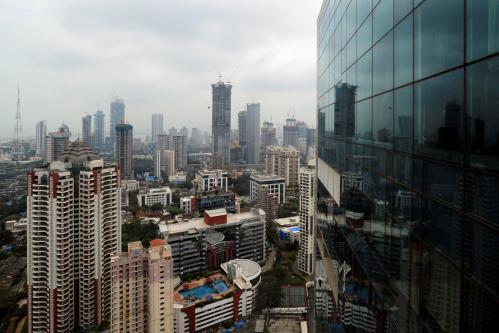As artificial intelligence technologies take over a larger number of tasks, India will face unique impacts of automation relative to other countries. With its large and young population, advances in AI will affect India in aspects from jobs to quality of life. Incidentally, the Indian economy is currently ill-equipped to face the advent of automation and AI. Though India is one of the fastest growing large economies, higher growth is not converting into more jobs. There are measures that the country must take to meet the challenges that arise as different working environments steadily automate. These include boosting employment in sectors that are least vulnerable to automation and encouraging entrepreneurship among the youth. Political will and awareness of the challenges associated with automation are key prerequisites to prepare India for automation.
Employment in India
Imagining the future of work and workforce cannot be complete without considering its future in India—soon-to-be the world’s fifth largest economy. The country with a population of 1.3 billion is already facing a problem of employing its vast and growing workforce. In February 2018, its railroads had 63,000 job openings, for which 19 million people applied. An Ernst & Young study states that there are 17 million new entrants into the Indian workforce year after year, but only 5.5 million jobs created.
According to the State of Working in India 2018 report, a 10% increase in GDP now results in less than a 1% increase in employment—leading to counterintuitive higher unemployment in a fast-growing economy. The report also highlights the issue of income disparity: As labor productivity in organized manufacturing increased sixfold over the past three decades, wages increased just 50% over that period. Services may not be able to compensate for the job losses that automation causes in manufacturing, because major service industries like information technology and banking—the leading employers—face the threat of job losses thanks to changing industry dynamics and automation.
Our recommendations to realize the promise for AI and the potential of India start with better management of employment data. The Indian government should more proactively collect data on the state of employment to be able to plan for AI. The biometric information embedded in the unique identification numbers from Aadhaar data can be used to gauge the proportion of employed and unemployed in the economy.
With half of the country’s population below the age of 25, a pertinent step would be to prepare the young workforce by exposing them to the tech-enabled future of work with AI interfaces, machine learning, and increased automation. Online training programs, inclusion of AI and automation in the existing education curriculum, and corporate training programs for new hires can achieve this without much structural change and investment. For this, the political leadership also needs a better understanding of automation technologies and their implications for the Indian economy.
Transitioning to less vulnerable sectors
Instead of framing policies and incentives to create employment opportunities in areas that are going to be the first to lose jobs with the advent of automation and AI, it will be better to boost employment in the areas that are least vulnerable to automation. Sectors like healthcare and education have a high element of human engagement that cannot be easily automated. Jobs in the arts, entertainment, and sports are highly interpersonal and creative in nature, and likewise may not immediately be vulnerable to automation. These sectors should be boosted to revive the industry’s capacity to create jobs.
As a natural corollary, India needs to attract more talent towards the humanities, arts, crafts, and sports than STEM. With the Indian Institute of Technologies, India has built islands of excellence in STEM education, but has failed to repeat this success in other fields of education. There is an argument that holds that more STEM education won’t protect our jobs from robots. Too much focus on STEM has the inherent risk of over-saturation of few sectors over the others, hampering overall economic development.
Labor-intensive industries like tourism and arts should be aggressively pushed. India currently has a 1.2% share of international tourism, leaving much room to grow. While a grand scheme at the federal level will be instrumental in laying down the vision—implementation will have to be granular and decentralized. India is already the eighth largest exporters of creative goods, according to a UNCTAD report. The country’s creative goods exports nearly tripled from USD $7.4 billion in 2005 to USD $20.2 billion in 2014. With a proactive government-backed initiative to promote arts, India has significant potential to partake in the rising global market for creative goods that encompasses food, fashion, jewelry, handicrafts, movies, interior design, gaming, animation, and entertainment.
Boosting startups and entrepreneurship among youth can help. The rise of entrepreneurship courses in universities is instrumental in creating a startup culture in the country. Higher government procurement of goods and services from domestic startups can also boost entrepreneurship. Many small enterprises, instead of massive factories, are the more likely future of work in India.
The overall success of AI will rest on how a large and complicated country like India meanders towards becoming future-ready. If India fails to smoothly ride the AI wave that is taking shape in the developed world, it will be a setback for the AI revolution. For India to succeed, it needs concrete measures that go beyond the ongoing policy discussions.











Commentary
How India can prepare its workforce for the artificial intelligence era
April 22, 2019